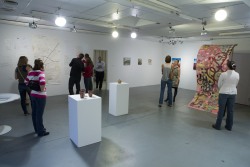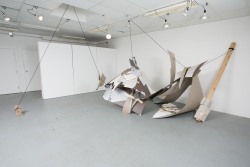Backspace offers artists a place to re-work, re-invent and re-invigorate.
On the first Friday of each month, nearly a dozen artist spaces in Peoria open their doors to the public. Organized by the Central Illinois Artists Organization, better known as CIAO, the First Friday studio tour is undoubtedly the most successful development on the local arts scene in recent memory. And not only does it offer a checklist of galleries for arts patrons, it’s catalyzed direct connections with the artists themselves.
“People have really latched onto that idea of artists and artist spaces,” notes Heather Brammeier, painter and associate professor of art at Bradley University.
“There was a craving for it,” agrees Erin Buczynski, Bradley’s director of galleries, exhibitions and collections. The two women are members of Backspace Collective, one stop on the First Friday circuit. Formed about the same time as CIAO, both organizations are run directly by their artist-members, and as a result, they naturally share a do-it-yourself (DIY) mindset and aesthetic.
Raw and Unpolished
The origins of Backspace date back to 2009, when its founding members took on the ambitious task of creating a modern, urban gallery that would embrace risk-taking approaches to contemporary art. It was a slow climb at first, with untold hours spent cleaning up, painting the walls, and working to secure nonprofit status. The inaugural opening took place in October of 2010, and over its first year, Backspace hosted five group exhibitions, in addition to several video screenings and a spoken word performance.
But just as the organization was beginning to establish itself, all six of the original members found jobs elsewhere, and one by one, each left town. That kind of shakeup might easily have put an end to the small collective, were it not for Buczynski and Brammeier. “They were looking for someone to keep it going,” Brammeier explains, “and both of us thought it was too good to let it go away.”
 Though the cast of players shifted, the group’s mission did not, nor did its DIY approach. “It’s not as polished as [some of the other galleries],” says Brammeier. “That’s actually really attractive to many artists, and to our audience. They like that it’s a little more raw.”
Though the cast of players shifted, the group’s mission did not, nor did its DIY approach. “It’s not as polished as [some of the other galleries],” says Brammeier. “That’s actually really attractive to many artists, and to our audience. They like that it’s a little more raw.”
Indeed, Backspace is far from flashy, and if you don’t know where to look, you might not find it at all. Tucked away on the 600 block of Main Street behind the Basket Case, Peoria’s long-running karaoke bar, its semi-hidden location and unpolished disposition—the concept of the gallery as a work in progress—is reflected in the very name itself.
“The whole name of Backspace is literally the keyboard key—the delete button,” Buczynski explains. “Being able to take chances and rethink… Having the opportunity to go back and try again… that there’s no failure in that—there’s always that key that lets you go backwards.”
“It’s a place where artists can try something they haven’t had the opportunity to try before,” adds Brammeier. “And we want to give them free reign as much as we can.”
The Scope of Discourse
With the artists in charge, they have a lot of input into the goings-on at Backspace. Not only is there a members’ exhibition every September, they can also curate their own exhibitions and events. “It’s often the members themselves who are motivated to bring something to the space,” notes Buczynski. “They’re the ones with exciting ideas… who really get motivated and bring that to the table.”
One such event took place last December in observation of the winter solstice and the much-hyped end to the Mayan calendar, which came and went without bringing about Armageddon. The brainchild of Backspace member Sarah Nesbit, Darkspace was a collaborative drawing event executed in near-total darkness. Over the course of three hours, an eclectic, musical soundtrack—in four parts, one for each season—was the primary sensory input for a revolving cast of participant artists, who filled the stark, white walls and floors of Backspace with a kaleidoscope of chalk and color.

“I was interested in combining energies with artists and the public and seeing what we could create,” Nesbit explains. “Honestly, I wasn’t sure if the final product was going to be interesting formally—I thought it might be more about the experience. But when the lights came on, it had accumulated into kind of a neo-urban cave painting, which did make for a strong visual element.”
Having recently completed a residency at the Prairie Center of the Arts, Nesbit is the current artist in residence at Backspace, and the group’s third overall. The three-month program, which began last year, is another benefit for Backspace members. “It gives the artist a free space to work, which they really need,” says Brammeier, “and exposure to whoever comes in to see the gallery.”
It’s also a valuable opportunity for the group’s interns to connect with professional artists trying to build careers for themselves. “They will gallery-sit… and sometimes they get to interact with the artist in the studio,” says Brammeier. “They also have opportunities to help install exhibitions, take exhibitions down, and just learn more about what a not-for-profit is, and everything that entails.”
Now in its third year, Backspace is on the upswing, with regular exhibitions, film screenings and other events commensurate with its growth. Among its fortes is the ability to showcase large installation pieces, such as last November’s exhibit by Katie Bell, which recast ceiling tiles, Formica and other building materials as a sprawling, patchwork sculpture, partly suspended from the ceiling. Re-assembling those common materials in unfamiliar ways, Bell’s work was compelling but not at all obvious, an appropriate reflection of Backspace’s mission to stretch the boundaries of artistic discourse in Peoria.
Connecting the Dots
Backspace lies half a block east of Main and Sheridan, in a neighborhood that’s been reinvigorated by a recent influx of new retail outlets and art spaces. Studios on Sheridan—another popular stop on First Fridays—opened last year in a former warehouse it shares with a handful of specialty shops. On the corner, Broken Tree Coffee specializes in artisan-roasted coffee, while down the road, the bar Blue has been a magnet for local hipsters since it opened in 2009. Across the street, a community garden has also helped catalyze the neighborhood’s resurgence since it started up last year.
“Main Street should be a place where everything is happening, but it hasn’t always been that way,” says Brammeier. “For a while, One World was the only hip, cool place to go. Now we’re hoping that all the new places will succeed and keep growing… We’d really like to be involved in building kind of a community.”
 With its raw, urban model of the arts, Backspace fits right into the neighborhood. “We like the area,” Brammeier affirms, “and the residents like that we’re there, because we’re bringing something that’s community-based and creative.”
With its raw, urban model of the arts, Backspace fits right into the neighborhood. “We like the area,” Brammeier affirms, “and the residents like that we’re there, because we’re bringing something that’s community-based and creative.”
And it doesn’t require much imagination to extend that Main and Sheridan corridor east toward downtown—where thirty-thirty Coffee Co. has quickly become a hotspot—and west all the way up to Bradley. “The dots start to connect very quickly,” says Buczynski, “and the energy… has been great. We see people coming from Studios on Sheridan to our events, and even people from the Basket Case coming over. We’ve seen that progress a lot because of CIAO.”
Endpapers and Beyond
Given its proximity and links to Bradley, it makes sense that Backspace would serve as a connector between the university and the arts community at large. That relationship will soon become clearer with a series of upcoming, interrelated events.
The Bradley International Print and Drawing Exhibition, a prestigious competition held every two years, will be on display at the university throughout March and April. At the same time, Bradley’s Inland Visual Studies Center, where Buczynski serves as assistant director, will host its annual symposium on April 4th and 5th. Over at Backspace, a juried exhibition entitled Endpapers will run concurrently with both, addressing a theme that’s purposefully aligned with the symposium’s focus on Midwestern book arts.
“Endpapers” are the unused pages at the beginning and end of books that connect the inside pages to the cover. “[The exhibition] will look at how artists have traditionally utilized these otherwise blank pages,” says Brammeier. “The participating artists will be repurposing endpapers from books, or addressing that idea somehow in their artwork.”
The juror for the exhibition, Regin Igloria, runs North Branch Projects, a community project space and bookbinding facility in Chicago’s Albany Park neighborhood. He will also be a panelist at the Inland Visual Studies Center Symposium, and when the Endpapers exhibition wraps up in Peoria, it will travel to North Branch. “So it’s a really great opportunity for the artists,” says Buczynski. “It’s like a dual exhibition.”
Looking to the future, the members of Backspace are working on their 501(c)(3) tax-exempt status while gearing up for a slate of exhibitions in 2013. Meanwhile, Brammeier says the space could be used for any number of arts-related events, from poetry slams to film screenings. But whatever the artists bring to the table, it’s sure to challenge the observer.
“We know that people won’t always like what they see at Backspace,” says Buczynski, “but we’d like everybody to have the opportunity to be exposed to art and decide for themselves what they like.” a&s
Endpapers: Before the Beginning and After the End, will run at Backspace Collective from March 1st to April 21st. An opening reception will be held on April 5th. For more information, visit wearebackspace.org.


